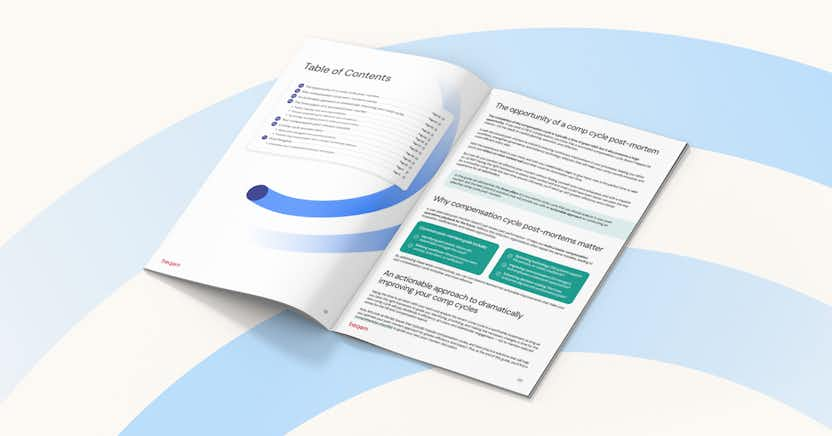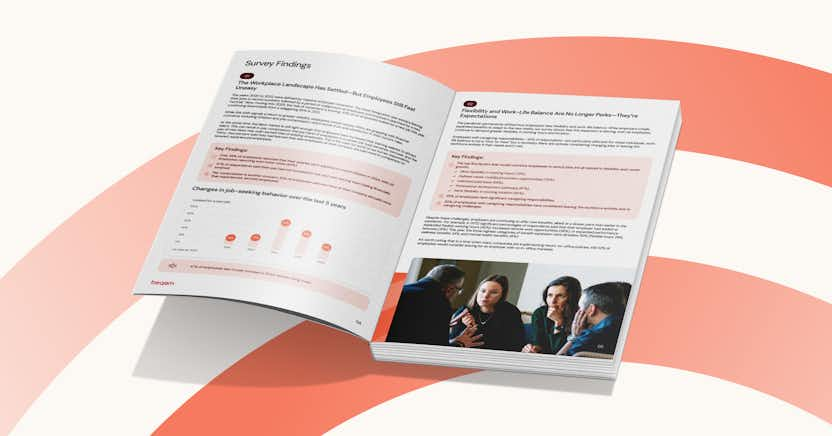Maximizing Effectiveness with Pay for Performance

In today’s business landscape, where competition is fierce and talent retention is crucial, organizations are continually seeking strategies to incentivize performance and drive productivity. Among the various approaches, "Pay for Performance" has long been the standard rallying cry for compensation planners looking to align employee pay with their contributions to organizational goals, en route to achieving a high-performance culture.
However, navigating this intricate terrain requires a nuanced understanding of its underlying mechanisms and considerations. Let's take a deep dive to see what Pay for Performance is all about, and whether it's the right approach for your company.
Understanding Pay for Performance: A Deep Dive
Key elements of Pay for Performance
Pay for Performance encompasses a multifaceted approach to compensation management, integrating several key elements to drive desired outcomes. At its core, this model emphasizes the direct correlation between a worker's performance and their remuneration. Key elements include:
- Performance Metrics: Defining clear and measurable performance metrics is essential for assessing employee contributions accurately. These metrics may vary across roles and departments but should align with overarching organizational objectives.
- Goal Setting: Establishing SMART (Specific, Measurable, Achievable, Relevant, Time-bound) and agile goals provides your people with clear expectations and benchmarks for performance evaluation. Transparent goal setting fosters accountability and empowers workers to strive for excellence.
- Feedback Mechanisms: Regular feedback loops enable ongoing performance assessment and facilitate continuous improvement. Constructive peer and manager feedback not only acknowledges achievements but also identifies areas for development, promoting a culture of growth and learning.
- Performance Evaluation: Implementing robust performance evaluation processes ensures fairness and objectivity in assessing employee contribution. Reviews should be conducted systematically, considering both quantitative metrics and qualitative feedback, with an eye towards bringing out the greatness in your people.
- Compensation Structure: Designing a flexible remuneration structure that rewards high performers while providing opportunities for improvement is critical. This may include merit-based pay increases, bonuses, or other incentives tailored to individual and organizational performance goals and outcomes. A strong compensation planning tool is indispensable for this.
Pay for Performance models: A closer look
Navigating the complexities of Pay for Performance involves understanding various models tailored to meet organizational needs and objectives. These models include:
Merit-based models: rewards for excellence
Merit-based pay structures reward employees based on individual performance and accomplishments. High-performers receive higher merit increases or bonuses, incentivizing continued excellence and fostering a culture of meritocracy within the organization.
Variable compensation: aligning pay with performance
Variable reward models tie incentive payments, such as bonuses, directly to specific performance outcomes or key performance indicators (KPIs). By aligning financial rewards with predetermined metrics, organizations can incentivize desired behaviors and outcomes, driving performance and goal attainment.
Team-base incentives: fostering collaboration
Team-based incentive programs promote collaboration and collective goal achievement by rewarding team performance rather than individual contributions. These programs encourage cooperation, knowledge sharing, and mutual support among team members, ultimately driving collective success and organizational effectiveness.
Advantages of implementing Pay for Performance
Implementing a Pay for Performance framework, if done effectively with a solid compensation management software platform, offers numerous benefits that can significantly impact organizational outcomes and employee engagement. Some of the key advantages include:
Enhancing employee motivation and engagement
Pay for Performance aligns employees' financial incentives with their performance outcomes, creating a direct link between effort and reward. This provides transparency and equity in pay which motivates workers to strive for excellence, leading to increased job satisfaction, engagement, and commitment to organizational goals.
Driving business growth and efficiency
By incentivizing high performance, Pay for Performance stimulates productivity and efficiency throughout the organization. Employees are encouraged to focus their efforts on activities that contribute to strategic objectives, resulting in improved performance metrics, enhanced operational effectiveness, and ultimately, sustainable business growth.
Attracting and retaining top talent
Competitive comp packages tied to performance outcomes are attractive to top talent seeking recognition and reward for their contributions. Pay for Performance signals to prospective hires that their efforts will be valued and rewarded, strengthening the employer brand and making the organization more appealing in the competitive talent market. Moreover, it helps in retaining top performers by continuously recognizing and rewarding their achievements, reducing the risk of talent turnover.
The flip side: challenges of Pay for Performance
While Pay for Performance offers compelling advantages, its implementation is not without challenges. Addressing these challenges effectively is essential for maximizing the effectiveness of this reward model. Some key challenges include:
Balancing fairness and competition
Maintaining a balance between fairness and competition is crucial in Pay for Performance systems. While rewarding high performers is essential for driving excellence, it's equally important to ensure that the compensation structure remains fair and equitable for all employees. Disparities in pay or perceived favoritism can undermine morale and erode trust within the organization.
Managing the impact on team dynamics
Introducing individual performance incentives in a team-based environment can sometimes lead to tension or conflict among team members. It's essential to foster a culture of collaboration and mutual support while still recognizing and rewarding individual contributions. Effective communication, transparent goal-setting, and clear performance expectations can mitigate potential conflicts and promote a cohesive team environment.
Addressing the risks of short-termism
Pay-for-performance models focused solely on short-term results may incentivize behaviors that prioritize immediate gains over long-term sustainability. Organizations must strike a balance between short-term performance incentives and the pursuit of strategic, sustainable growth. Incorporating measures to evaluate both short-term achievements and long-term impact ensures that Pay for Performance initiatives align with broader organizational objectives.
Is Pay for Performance really the right motivator for employees?
While Pay for Performance makes intuitive sense and has been well tested as a motivator, determining its suitability for your organization requires careful consideration of various factors. Here's a summary to aid in decision-making:
Assessing organizational culture and values
First and foremost, consider your organization's culture, values, and overarching goals. Pay for Performance may be well-suited for organizations that prioritize meritocracy, individual accountability, and performance-driven cultures. However, if your organization more highly values collaboration, teamwork, and collective success, alternative remuneration models may be more appropriate.
Understanding employee preferences and motivations
Take into account the preferences and motivations of your people. While some individuals may be highly motivated by financial incentives and tangible rewards, others may prioritize non-monetary factors such as recognition, autonomy, or opportunities for personal and professional development. Conducting surveys, focus groups, or one-on-one discussions can provide valuable insights into what drives employee engagement and satisfaction.
Evaluating performance measurement and evaluation systems
Consider the effectiveness of your organization's performance measurement and evaluation systems. Pay for Performance relies heavily on objective performance metrics and robust review processes to accurately assess employee contributions. If your existing systems are unreliable, subjective, or lack visibility, implementing Pay for Performance may yield inconsistent results and erode trust among the workforce.
Exploring alternative compensation models
While Pay for Performance is widely used, it's not the only approach to motivating employees. Some alternative models include:
Skill-based pay
Skill-based pay means compensating people based on their skills, competencies, or qualifications rather than performance outcomes.
Pros:
- Encourages Skill Development: Employees are motivated to enhance their skills and competencies to increase their earning potential.
- Fairness and Equity: Compensation is tied to objective criteria such as skills and qualifications, promoting fairness and reducing the potential for perceived favoritism.
- Retention and Recruitment: Skill-based pay can attract and retain top talent by offering clear pathways for career progression and advancement based on skill acquisition.
Cons:
- Complexity in Implementation: Designing and administering skill-based pay systems can be complex and resource-intensive, requiring accurate assessment of skills and competencies.
- Subjectivity in Skill Assessment: Assessing and quantifying skills objectively can be challenging, leading to potential discrepancies and disputes.
- Limited Flexibility: Skill-based pay may not adequately reward employees for performance or contributions beyond their designated skillset, potentially limiting motivation and engagement.
Profit-sharing
Profit-sharing means sharing organizational profits with employees as a form of incentive, thereby fostering a sense of ownership and alignment with organizational success.
Pros:
- Alignment with Organizational Goals: Profit-sharing aligns employee interests with organizational success, fostering a sense of ownership and accountability.
- Motivation for Performance: Employees are motivated to contribute to increased profitability through enhanced productivity, efficiency, and innovation.
- Employee Engagement: Sharing profits with your workers can enhance morale, engagement, and commitment to organizational success.
Cons:
- Dependency on Organizational Performance: Profit-sharing is contingent upon organizational profitability, making it less predictable and reliable than fixed compensation structures.
- Complexity in Calculation: Determining profit-sharing allocations can be complex and opaque, leading to confusion and dissatisfaction among employees.
- Potential for Disparities: Disparities in profit-sharing allocations may arise based on factors such as seniority or role, leading to perceptions of inequity and resentment.
Gainsharing
Gainsharing means rewarding workers based on improvements in productivity, efficiency, or cost savings achieved through their efforts, designed to promote collaboration and continuous improvement.
Pros:
- Focus on Continuous Improvement: Gainsharing promotes a culture of continuous improvement by rewarding employees for achieving specific performance targets or operational efficiencies.
- Enhanced Collaboration: Gainsharing fosters collaboration and teamwork as employees work together to identify and implement process improvements that result in cost savings or productivity gains.
- Financial Incentives for Non-Production Employees: Unlike traditional profit-sharing, gainsharing can provide financial incentives for non-production workers (e.g., administrative staff, support functions) by linking rewards to departmental or organizational performance metrics.
Cons:
- Complexity in Metrics and Measurement: Establishing meaningful performance metrics and measurement systems can be challenging, particularly in non-production areas where outcomes may be less tangible or quantifiable.
- Resistance to Change: Employees may resist changes to existing processes or procedures required to achieve gainsharing goals, impeding implementation and effectiveness.
- Short-Term Focus: Gainsharing initiatives focused solely on short-term gains may prioritize immediate cost savings over long-term strategic objectives, potentially undermining sustainability and innovation.
Making an informed decision
Each of these models offers unique advantages and challenges, and the optimal approach may vary depending on organizational context, industry norms, and workforce demographics.
Ultimately, the decision to implement Pay for Performance or pursue alternative compensation models should be informed by a comprehensive understanding of your organization's unique needs, culture, and objectives. Consider consulting with other HR professionals, outside specialists, and organizational leaders to weigh the pros and cons, assess feasibility, and develop a tailored approach that aligns with your organization's values and goals.
By carefully evaluating these factors and soliciting input from key stakeholders, you can make an informed decision about whether Pay for Performance is the right motivator for your employees and take steps to implement it effectively or explore alternative approaches that better suit your organization's needs.
Whatever pay model you choose, be sure you have the right technology to implement it correctly to get the full benefit. beqom's total compensation solution adapts to any rewards model, giving you ultimate flexibility and control, and ensuring you don’t need to compromise on your compensation strategy. And, it’s integrated with our continuous performance management platform that helps you build a culture of performance and improvement. Managing performance and compensation together is the ultimate way to ensure you can deliver Pay for Performance.

















